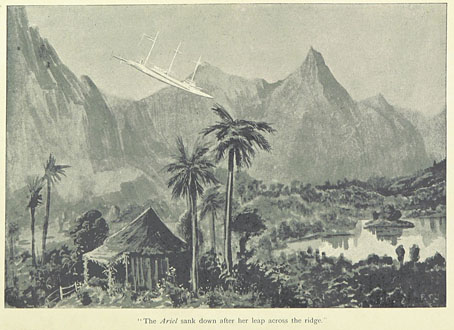
The British Library’s recent uploading of a million copyright-free images to Flickr has been a mixed blessing. On the one hand it’s an exemplary gesture on the Library’s part, on the other I wish they’d archived their images somewhere other than Flickr where the recent interface changes have made using the site for any length of time a very frustrating business.
Complaints aside, the unsorted BL haul is being slowly sifted by those who aren’t dissuaded by Yahoo’s iniquities. A recent set labelled Science Fiction is comprised as much of science fact as fiction but it does include these illustrations from The Angel of the Revolution: A Tale of the Coming Terror (1893), a novel of aerial warfare and anarchist revolt by British author George Griffith. This is one of several works from the late Victorian era which show how lazy it is to characterise the period as a time of unthinking imperialism:
First published in 1893, The Angel of the Revolution is a fantastical tale of air warfare in which an intrepid group of Socialists, Anarchists and Nihilists defeat Capitalism with their superior knowledge of dirigibles. Led by a crippled, brilliant Russian Jew and his daughter, Natasha, The Brotherhood of Freedom establishes a ‘pax aeronautica’ over the world, thanks to the expertise of Richard Arnold, a young scientist. Arnold falls in love with Natasha (the eponymous Angel), and Griffith builds a utopian vision of Socialism and romance.
As well as writing a cracking good story, Griffith is also remarkably prescient in predicting future technology, including air travel, tidal power, and solar energy. He also engages with timeless debates over social responsibility. Griffith imagines a world in which the wealth of the obscenely rich is sequestered, their property seized for the public good, and their businesses nationalised. Those with unearned incomes are forced to either pay punitive tax, or to undertake equivalent labour in the community. Griffith’s message lacks subtlety, but it couldn’t be more pertinent in the twenty-first century. (Précis swiped from here.)
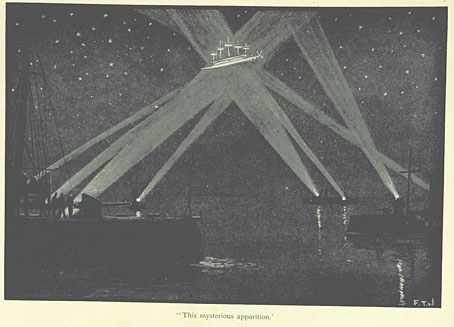
Griffith’s novel is essentially Jules Verne’s Robur the Conqueror (1886) with a helping of revolutionary politics; even the aircraft are similar, with Griffith’s illustrator, Fred T. Jane, depicting an armed sky-boat held aloft by the same vertical propellers as those used by Robur’s machine. Jane (not “Janes” as they name him on the Flickr pages) later founded the Jane’s series of warship and aircraft catalogues so it’s fitting that his illustrations combine both those craft in a single design.
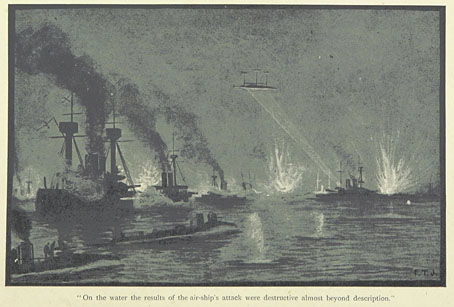
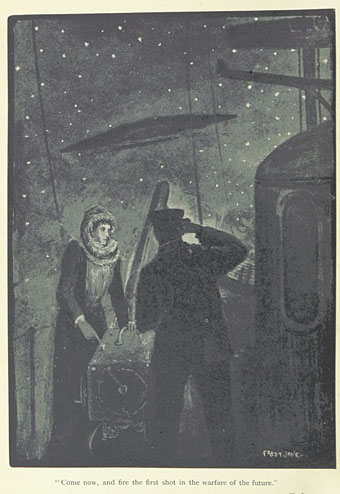
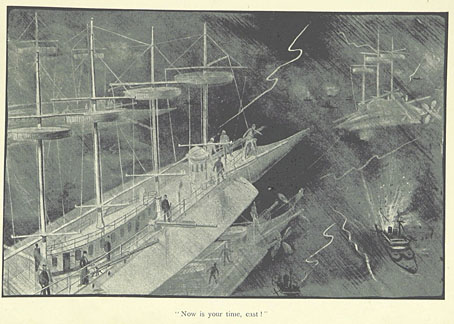
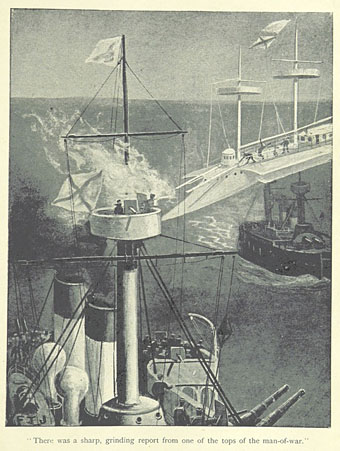
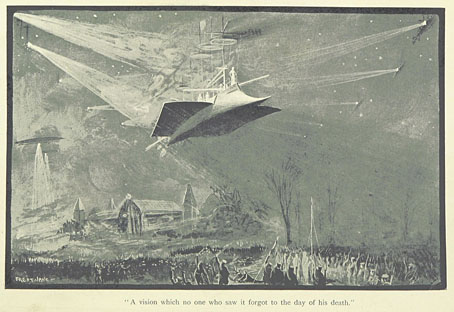
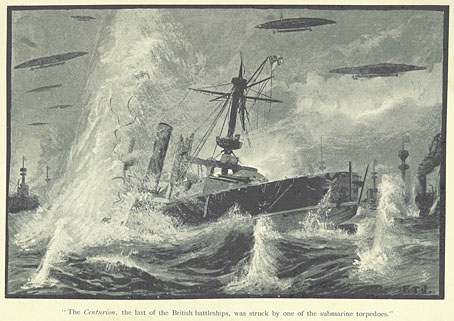
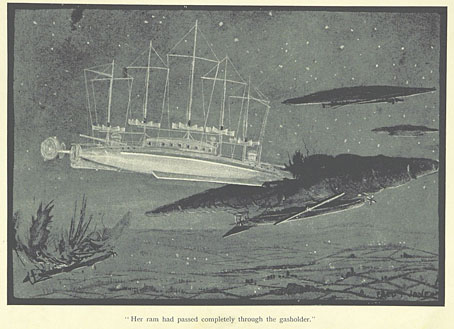
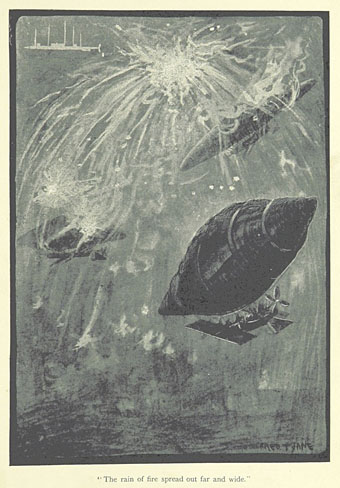
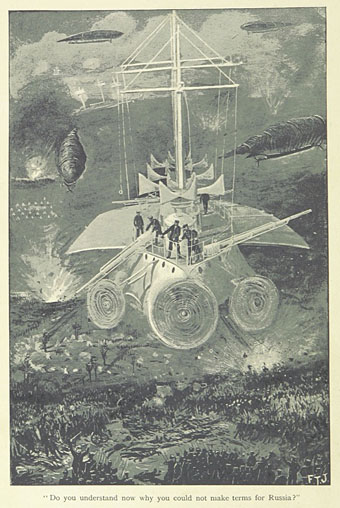
Elsewhere on { feuilleton }
• The illustrators archive
Previously on { feuilleton }
• The Time Machine
• A Strange Manuscript Found in a Copper Cylinder
• The End of Books, 1894
• Le Vingtième Siècle by Albert Robida
• La Vie Électrique by Albert Robida

John Ptak picked out the last of the illustrations you show.
The attitudes of the tiny human figures reminded me of this image, a tribute to the Golden Age of Facial Hair:
http://en.wikipedia.org/wiki/File:Anton_Romako_001.jpg
I knew it! I knew that some day the Anarchists superior knowledge of dirigibles would prove useful for defeating Capitalism. At least, that it happened in a parallel universe is comforting enough, and gives hope for our own continuum’s future.
That last image and caption are worthy of Glen Baxter!
Recently picked up a first edition of this as a Christmas present for my father. It was a big seller at the time, and affordable copies can still be found. Didn’t realise that the illustrations were by that Jane – the book also has a wonderful colour printed board design.
That *had* to have been an influence on Moorcock’s Warlord of the Air? And several of the images (2, 5 and 7 in particular) reminded me of panels in the first volume of Alan Moore’s League of Extraordinary Gentlemen (Moriarty and Fu Manchu’s air battle).
I ought to have noted that the Internet Archive has several editions of this book (and other Griffith titles):
https://archive.org/details/angelofrevolutio00grifiala
Among them is the sequel, Olga Romanoff, or, The Syren of the Skies (1894). Griffith also wrote a book of sf tales, Stories of Other Worlds (1900), and many other novels with fantastic themes such as The White Witch of Mayfair (1902), and The Mummy and Miss Nitocris: A Phantasy of the Fourth Dimension (1906).
Rob: Moorcock writes about this novel (and reprints a piece by Griffith) in Before Armageddon (1975). I’ve not checked but there’s an edition of New Worlds magazine that MM and others put together in the mid-70s which featured many fake newspaper pages from alternate time-streams. Some of the text concerned airship anarchists, and may have been taken from Griffith. I’m fairly sure Warlord of the Air owes a debt to Griffith, Moorcock’s output during the 1970s drew heavily on overlooked Victorian authors.
Thanks for the IA link. He had an ear for fabulous titles!
Darned free internet books are totally warping my New Year’s get-through-the-TBR-pile-without-buying-any-more-new-books Resolution…